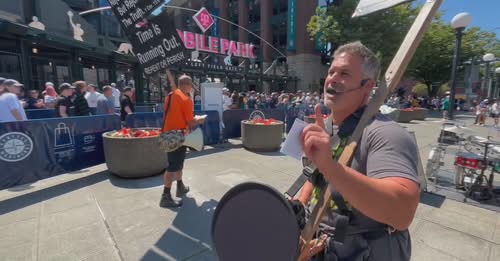As the 2025 MLB trade deadline looms large over the horizon, speculation is intensifying regarding which teams will look to be buyers and which will sell off assets in hopes of future gains. The Seattle Mariners, currently in the thick of the playoff race and boasting one of the most electrifying young pitching staffs in baseball, are widely expected to be aggressive. The front office has been carefully cultivating a blend of homegrown talent and cost-controlled veterans, and with a farm system ranked among the deepest in the league, the expectation from many within the baseball industry is that Seattle is primed to leverage that depth for a marquee acquisition. But according to The Athletic’s Keith Law, the player most likely to bring back a big-time return isn’t buried in Tacoma or dominating in Arkansas—it’s someone already wearing a big-league Mariners uniform.
Speaking to Brock Huard and Mike Salk on Seattle Sports, Law shared his contrarian take on the team’s best trade chip, throwing a curveball of sorts to fans and analysts who have been poring over minor league box scores and scouting reports. In his view, the most valuable trade asset the Mariners could realistically part with is none other than utilityman Dylan Moore. While Moore’s name doesn’t carry the same cachet as a top prospect like Harry Ford or Cole Young, Law argues that the 31-year-old Swiss Army knife offers a rare combination of versatility, affordability, and above-average production that contending teams covet down the stretch.
Moore’s emergence as a critical cog in the Mariners’ machine over the past two seasons has been one of the more underappreciated stories in Seattle’s ascent. Whether filling in at shortstop, holding down the corner outfield, or providing timely hits off the bench, Moore has proven himself to be a modern-day super-utility player. In 2024, he posted career-highs in OPS and WAR, while playing six different positions and rarely missing a beat. His value goes beyond traditional statistics. He allows the Mariners to rotate stars like Julio Rodríguez, J.P. Crawford, and Cal Raleigh through rest days without a significant drop-off in performance. That level of flexibility is a luxury, particularly for playoff teams navigating injuries or looking for matchup advantages in October.
Law’s argument isn’t that the Mariners should rush to trade Moore. Instead, it’s that if Seattle is serious about landing a difference-maker—say, a top-tier bat or a veteran starting pitcher—then Moore’s current value might be at its zenith. Unlike prospects who carry uncertainty and development risk, Moore is a proven commodity. His modest salary makes him attractive even to teams with payroll limitations, and his team control through 2026 adds to the appeal. It’s a rare case where a win-now player could be parlayed into another win-now piece, perhaps one with a slightly higher ceiling or better positional fit.
Of course, the Mariners find themselves in a delicate position. Their farm system is stocked with promising players, but many are still years away from making a tangible impact in the big leagues. Outfielder Lazaro Montes and shortstop Michael Arroyo are tantalizing talents, but trading them now would mean cashing in on upside rather than certainty. Catcher Harry Ford, who’s been praised for his advanced approach at the plate and leadership behind it, is drawing considerable interest from rival executives. But given the inherent risks of trading young catchers who can hit, Ford may be a player the Mariners prefer to hold onto unless blown away by an offer.
General manager Justin Hollander and president of baseball operations Jerry Dipoto have never been shy about making bold, creative moves. Dipoto, known for his frequent wheeling and dealing, has often leaned into unconventional trades that challenge traditional baseball orthodoxy. Remember when the Mariners acquired Luis Castillo in a blockbuster deal that sent several prized prospects to Cincinnati? That trade wasn’t universally praised at the time, but Castillo has since become the ace of the staff and a foundational piece. The front office understands the calculus of trading potential for performance and doesn’t shy away from difficult decisions when the payoff justifies the risk.
That’s why Moore’s inclusion in trade talks shouldn’t come as a shock. His value to Seattle is evident, but it’s also precisely the kind of value that could fetch a meaningful return. Consider a team like the Milwaukee Brewers or the Toronto Blue Jays—both clubs are in the market for depth and could desperately use someone like Moore, especially given their injury histories and inconsistent bench production. A trade that sends Moore to such a team could net Seattle a bat capable of sliding into the middle of their lineup, or perhaps a controllable starting pitcher to deepen an already formidable rotation.
While fans might balk at the idea of trading a fan favorite like Moore, baseball is a business defined by windows. Seattle’s current core—featuring Rodríguez, Raleigh, George Kirby, and Logan Gilbert—is not only talented but affordable. However, that won’t always be the case. Arbitration and free agency will eventually demand tough decisions on payroll allocation. The 2025 trade deadline is a chance to maximize the current moment before financial constraints begin to limit roster flexibility. Trading a player like Moore might not just be about upgrading for this October—it could also be about positioning the team to remain competitive in the years ahead.
There’s also the matter of how such a trade would affect the clubhouse. By all accounts, Moore is beloved by teammates and respected for his work ethic and professionalism. He’s the kind of player who keeps things loose during a slump and sets the tone during early-morning spring training drills. Removing that presence isn’t without consequences, but it’s the sort of intangible calculus that front offices must weigh against the potential on-field benefits of a deal.
Law’s insight comes at a moment when the Mariners are being pulled in multiple directions. They’re good enough to contend now but young enough to believe their best baseball lies ahead. They have assets to trade but not so many that they can afford to miss. The challenge for Dipoto and company is figuring out how to walk that line with precision. Do they trade from depth or dangle something from the big-league roster? Do they go all-in or hold their cards until the offseason?
There’s a precedent for this kind of move in recent Mariners history. In 2021, Seattle shocked the baseball world by trading reliever Kendall Graveman to the Houston Astros, a division rival, in the middle of a playoff race. The clubhouse reaction was swift and visceral. Graveman had been dominant, and players felt blindsided. But the trade brought back infielder Abraham Toro, a younger, cheaper, and more versatile option who fit the team’s long-term vision. While Toro never quite became the impact player Seattle hoped for, the logic behind the trade offered a window into how the front office evaluates decisions.
A similar decision looms now with Moore. The Mariners aren’t just chasing wins—they’re managing a portfolio of assets, balancing immediate needs with long-term stability. In that context, the idea of Moore as a trade chip makes sense. He’s valuable because he produces, and that production is what could unlock a deal for someone even more impactful.
The question, then, is what kind of return Moore could bring. The market for versatile veterans is often strong, especially when they come with multiple years of control. Depending on the demand, Moore could headline a package for a player like Pete Alonso if the Mets finally decide to part with the slugger. Or perhaps he could be the key piece in a deal for a controllable starter like Miami’s Edward Cabrera or Pittsburgh’s Mitch Keller. In a league that prizes efficiency, versatility, and clubhouse fit, Moore checks a lot of boxes.
There’s also the possibility that Seattle could pair Moore with a mid-tier prospect to sweeten a deal. That kind of flexibility gives them a leg up in negotiations, especially compared to teams whose farm systems are top-heavy or already depleted. Whether the Mariners look to add a middle-of-the-order bat, bolster their bullpen, or secure a veteran starter, Moore represents the kind of plug-and-play option that other GMs will find enticing.
As the trade deadline nears, the Mariners find themselves at a crossroads that many contenders face each year. The decision isn’t just about what player to acquire; it’s about what price you’re willing to pay and which direction you want to take your organization. In that regard, Dylan Moore is more than a utility player—he’s a symbol of the Mariners’ present and a potential key to their future. Whether he stays or goes could say a lot about where this team believes it stands in its championship arc.
For now, Moore continues to go about his business the way he always has—with professionalism, intensity, and a quiet confidence that endears him to coaches and fans alike. If he does end up being moved, it will be the end of a unique and productive chapter in Seattle baseball. But if he stays, perhaps the Mariners will find another path to improvement—one that doesn’t require parting with a known and trusted quantity. Either way, the trade deadline is shaping up to be a defining moment for a Mariners team that knows it’s close to something special.



